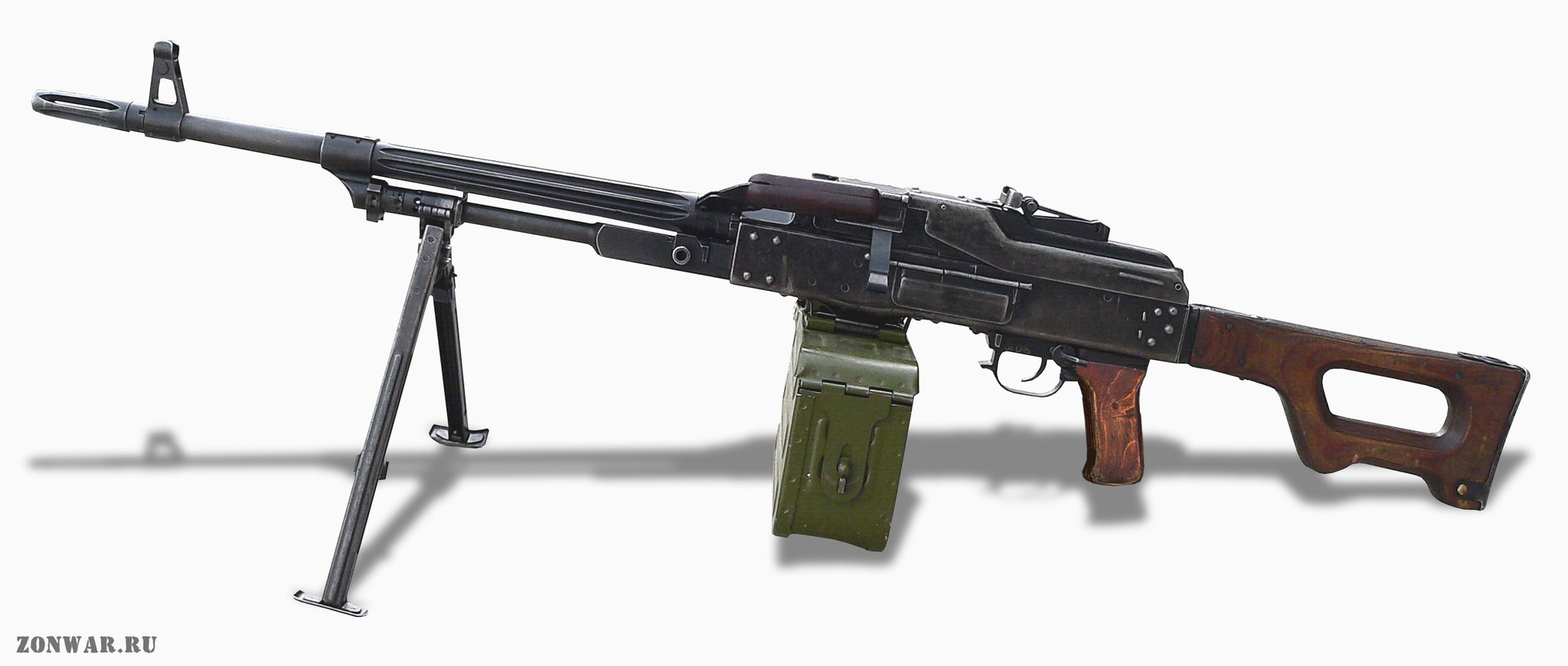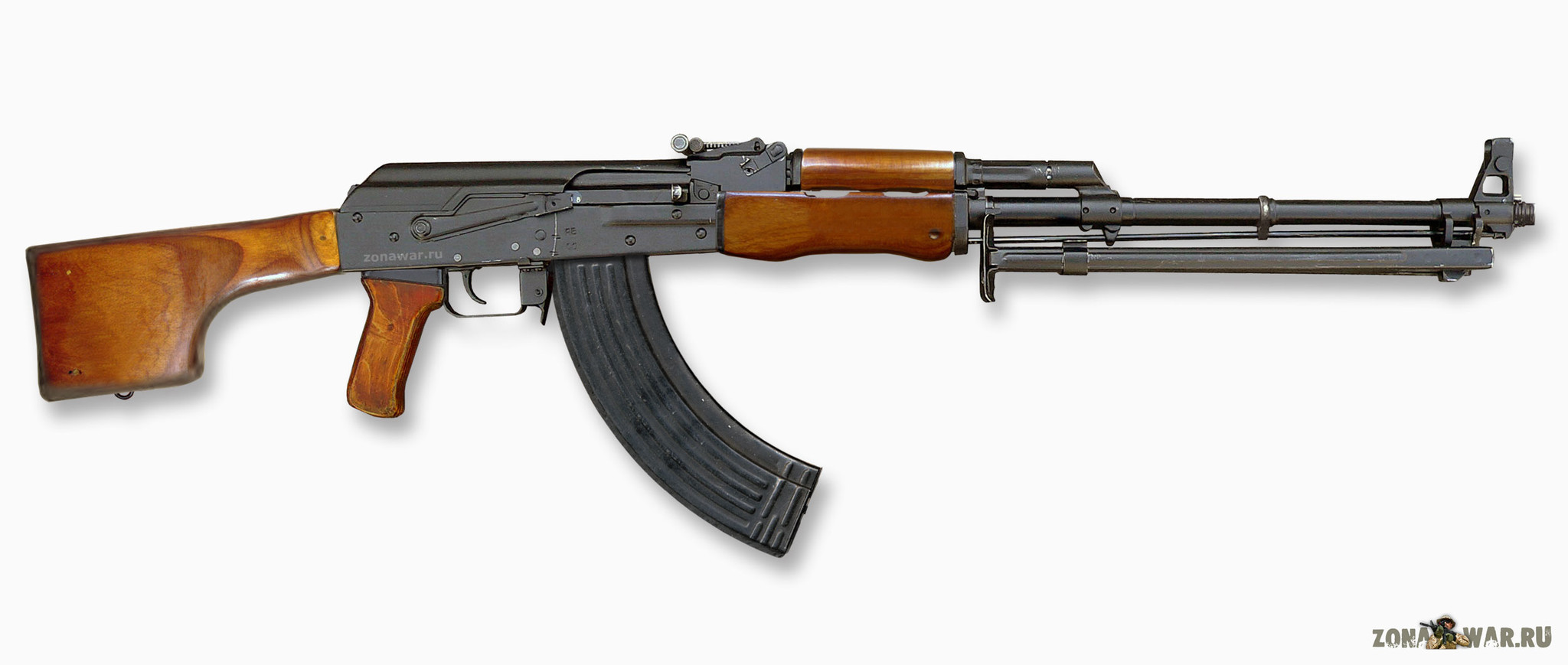 14.5 mm Vladimirov KPVT heavy tank machine gun
14.5 mm Vladimirov KPVT heavy tank machine gun
The national 14.5 mm Vladimirov heavy machine gun and its various versions are the world’s most powerful mass-produced heavy machine guns.
The Great Patriotic War uncovered the need for a more powerful machine gun than a 12.7 mm one.
Machine guns of this calibre had been under development even before the war In fact, the 14.5 x 114 mm cartridge was designed for automatic weapons, and after it had entered the inventory designers attempted to develop a 14.5 anti-tank machine gun, chambered for this round On the other hand, anti-aircraft machine guns had to be improved as well. The Main Artillery Directorate adopted specification requirements for the 14.5 mm machine gun in December 1942. Development of a new machine gun began an Kovrov-based Plant № 2. Several designers, including S. V. Vladsrmirov, decided to base the new machine gun on the 20 mm V-20 aircraft cannon. The 14.5 mm KPV-44 1944-vsntage Vladimirov heavy machine gun and an anti-aircraft machine gun prototype were submitted for service tests right after the end of the Great Patriotic War in May 1945. Based on the results of the service tests, the machine gun underwent further refinement, first and foremost, as far as reliable operation in adverse conditions was concerned.
In 1949 the Soviet Armed Forces fielded the 14.5 mm Vladimirov PKP infantry heavy machine gun on a field mount, designed by S. A. Kharykin, as well as several 14.5 mm anti-aircraft machine guns: the four-barrel ZPU-4, designed by I. S. Leshchmsky (divisional air defence system), the twin-barrel ZPU-2, designed by S. V. Vladimirov and G. P. Markov (regimental air defence system), and the single-barrel ZPU-1 developed by E. D. Vodopyanov and E. K. Rachinsky. Other 14.5 mm anti-aircraft machine guns including the ZU-2 for airborne forces and the ZGU-1i mountain system, were developed later on.
There was also the KPVB armoured-vehicle variant of the KPV, mounted on open armoured personnel carriers.
The machine gun proper was put into production at the Kovrov-based V. A. Degtyarev Plant (former Plant № 2 renamed in 1949).
The modified KPVT tank machine gun was mounted on heavy tanks (as an antiaircraft or a co-axial machine gun), combat reconnaissance vehicles, and armoured personnel carriers.
 14.5 mm Vladimirov KPV heavy machine gun
14.5 mm Vladimirov KPV heavy machine gun
The Vladimirov machine gun is short-recoil-operated. The pressure of expanding powder gases forces the breech block and the barrel rearwards. At the same time the barrel run out spring and the mainspring compress. The muzzle booster, sliding along the receiver cams, rotates the bolt head and unlocks the breech.
The barrel, unlocked from the bolt head, is carried forward by its spring, while the breech block continues its recoil extracting the next round from the feed mechanism and the spent case from the chamber, and drawing the ammunition belt into the gun.
The next round is forced down bolt head recesses by a cam-operated arm, displacing the case of the preceding fired round unto the ejection chute, and is lined up with its cap against the firing pin hole.
When the bolt has reached its rearmost position, energy is stored in the return spring and the buffer. This carries the bolt forward, driving a round into the chamber, locking the breech, and slipping the feed claws over the waiting round in the belt. The firing pin is driven through into the cap, whereupon the round is fired. The sequence is repeated until the trigger is lowered or the ammunition belt is spent.
 Field-stripped KPVT machine gun: 1 – barrel with the jacket and the flash suppressor; 2 – muzzle booster; 3 – extractor; 4 – feed mechanism base; 5 – electric solenoid trigger; 6 – receiver back-plate; 7 – mainspring; 8 – breech-block earner assembly; 9 – breech block; 10 – receiver cover; 11 – receiver
Field-stripped KPVT machine gun: 1 – barrel with the jacket and the flash suppressor; 2 – muzzle booster; 3 – extractor; 4 – feed mechanism base; 5 – electric solenoid trigger; 6 – receiver back-plate; 7 – mainspring; 8 – breech-block earner assembly; 9 – breech block; 10 – receiver cover; 11 – receiver
The receiver is fatted with a back-plate, which also serves as a stop for the cylindrical spiral three-thread mainspring. The receiver back-plate mounts the recoil buffer. The trigger mechanism providers for automatic fire only. The machine gun is fired from the rear sear. It is fitted with automatic safeties, which prevent breech locking and a discharge if the barrel is not properly attached, as well as the belt feed if a cartridge is not extracted from the link.
Ammunition feed is from a non-disintegrating metal open-link belt. The feed slide is mounted in the receiver cover and can be adapted for feed from either the right or the left side. The ambidextrous feed made installation of the KPVT machine gun on interconnected mounts easier. The cocking handle can also be mounted on either side of the receiver with the same end in view.
The tangent leaf U-notch rear sight is mounted in the rear part of the receiver, while the protected foresight is fitted on its front end.
At first the Vladimirov machine gun fired 14.5 x 114 mm cartridges, with the B-32 armour-piercing bullet and the BS-41 armour-piercing-incendiary bullet, already in production, as well as the BZT-44 armour-piercing-incendiary-tracer bullet, fielded simultaneously with the machine gun. In the 1950s — 1960s given a widespread use of machine guns, the Soviet Union fielded cartridges with the PZ adjustment-incendiary bullet and the MDZ instant incendiary bullet (for engaging air targets). The 14.5 mm cartridge with the BS armour-piercing-incendiary hard-alloy-cored bullet, which boasted a better armour penetration than the B-32 bullet, was tested as early as 1989.
Advantages of the machine gun include a relatively smooth operation (due to rollers mounted on recoiling parts), a lack of the necessity for fine adjustments of gaps, and a high reliability in various operating conditions.
The Kharykin wheeled mount for the PKP machine gun was based on a light artillery split-trail carriage. The light wheeled tripod mount, designed by K. A. Baryshev, entered service in 1955.
The KPVT tank machine gun was designed to be mounted co-axially with the main gun, as well as on turret, swivelling, and gun ring mounts. Thus, the KPVT was fitted with a detachable feed, a modified receiver, an electric solenoid trigger, and forward spent-case ejection. The machine gun was fitted with a long jacket, covering the entire barrel. All Vladimirov machine guns have been fitted with such jackets since 1956. Ammunition feed was from 50-round ammunition belts. In addition to national T-10 tanks, BTR-60, BTR-70, and BTR-80 APCs, and BRDM-2 reconnaissance armoured vehicles the KPVT was mounted on armoured vehicles of other Warsaw Pact member-slates. The KPVT version has turned out to have the longest life among the entire family of 14.5 mm machine guns.
 14.5 mm anti-aircraft machine guns including the ZU-2
14.5 mm anti-aircraft machine guns including the ZU-2
Specifications KPVT
Caliber: 14.5 mm
Cartridge: 14.5×114
Weight machine gun without: 52.5 kg
Overall length: 2000 mm
Barrel length: 1350 mm
Bullet muzzle velocity: 990-1000 m/sec
Effective rate of fire: 70-90 rds/min
Rate of fire: 600-650 rds/min
Sighting range: 2000 m
Ammunition belt capacity: 50 rds





Where is the barrel return spring!?